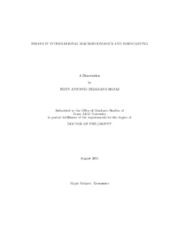| dc.description.abstract | This dissertation contains three essays in international macroeconomics and financial time series forecasting. In the first essay, I show, numerically, that a two-country New-Keynesian Sticky Prices model, driven by monetary and productivity shocks, is capable of explaining the highly positive correlation across the industrialized countries' inflation even though their cross-country correlation in money growth rate is negligible. The structure of this model generates cross-country correlations of inflation, output and consumption that appear to closely correspond to the data. Additionally, this model can explain the internal correlation between inflation and output observed in the data.
The second essay presents two important results. First, gains from monetary policy cooperation are different from zero when the elasticity of substitution between domestic and imported goods consumption is different from one. Second, when monetary policy is endogenous in a two-country model, the only Nash equilibria supported by this model are those that are symmetrical. That is, all exporting firms in both countries choose to price in their own currency, or all exporting firms in both countries choose to price in the importer's currency.
The last essay provides both conditional and unconditional predictive ability evaluations of the aluminum futures contracts prices, by using five different econometric models, in forecasting the aluminum spot price monthly return 3, 15, and 27-months ahead for the sample period 1989.01-2010.10. From these evaluations, the best model in forecasting the aluminum spot price monthly return 3 and 15 months ahead is followed by a (VAR) model whose variables are aluminum futures contracts price, aluminum spot price and risk free interest rate, whereas for the aluminum spot price monthly return 27 months ahead is a single equation model in which the aluminum spot price today is explained by the aluminum futures price 27 months earlier. Finally, it shows that iterated multiperiod-ahead time series forecasts have a better conditional out-of-sample forecasting performance of the aluminum spot price monthly return when an estimated (VAR) model is used as a forecasting tool. | en |


